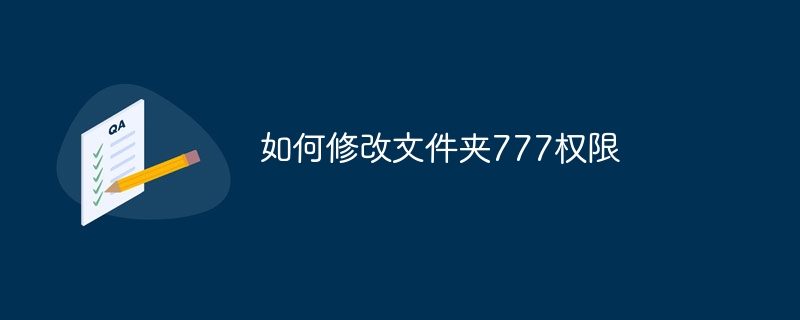Home >Common Problem >How to modify folder 777 permissions
How to modify the 777 permissions of the folder: 1. Understand the 777 permissions; 2. Back up important data; 3. Use the terminal or command line interface; 4. Navigate to the target folder; 5. Modify the folder permissions; 6. Verify permission changes; 7. Precautions. Detailed introduction: 1. Understand the 777 permissions. In Unix and Linux systems, file and directory permissions are represented by three numbers. The range of each number is 0 to 7. These three numbers represent the permissions of the file owner, The permissions of the group to which it belongs and the permissions of other users; 2. Back up important data, etc.

Modifying the 777 permissions on the folder is an important operation, which ensures that you have full read, write and execute permissions on the folder. Before doing this, make sure you understand the risks and take appropriate safety measures.
1. Understand 777 permissions
In Unix and Linux systems, file and directory permissions are represented by three numbers, each number ranges from 0 to 7. These three numbers represent the permissions of the file owner, the permissions of the group it belongs to, and the permissions of other users. The number 7 represents read, write, and execute permissions, so 777 permissions means that all users can read, write, and execute files in the folder.
2. Back up important data
Be sure to back up important files and data before modifying folder permissions. This is because incorrect permission settings can lead to data loss or security issues. It's a good practice to copy important files to another location or use a version control system for backup.
3. Use the terminal or command line interface
To modify the permissions of the folder, you need to use the terminal or command line interface. On Windows systems, you can use Command Prompt or PowerShell. On Mac and Linux systems, you can use the Terminal application.
4. Navigate to the target folder
Use the cd command to navigate to the target folder where you want to modify the permissions. For example, if the target folder is located on the desktop, you can use the following command to navigate to the folder:
cd ~/Desktop/target_folder
5. Modify folder permissions
To modify the permissions of a folder, you can use the chmod command. To give all users read, write and execute permissions, you can use the following command:
chmod 777 target_folder
This will set the permissions of the target_folder folder to 777, which means that all users can read Fetch, write, and execute files in this folder.
6. Verify permission changes
To verify whether the permissions of a folder have been changed successfully, you can use the ls -l command to view the detailed information of the folder. In the output, you should see permissions similar to the following:
drwxrwxrwx 1 user group 4096 Jul 19 12:34 target_folder
This means that the permissions for the target_folder folder have been set to 777.
7. Notes
1. Use 777 permissions with caution: Granting 777 permissions to a folder means that any user can read, write and execute the folder. operate. This can cause security issues, especially if the folder contains sensitive or confidential information. Use 777 permissions only when necessary, and revoke them promptly when you're done.
2. Do not abuse root or administrator privileges: When modifying folder permissions, avoid abusing root or administrator privileges. Use these permissions only when necessary and make sure you understand the risks. Incorrect operation may cause system instability or security issues.
The above is the detailed content of How to modify folder 777 permissions. For more information, please follow other related articles on the PHP Chinese website!